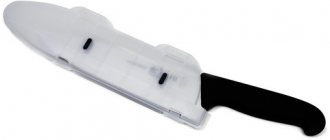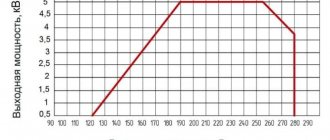What is knife polish
Musat is a tool that looks like a metal or ceramic rod with a plastic or wooden handle. To prevent hand cuts, there is a guard located between the handle and the working part of the tool.
The sharpening base of different products differs in the softness of the material. The surface of the rod can be smooth or rough. The advantage of musats is their magnetized surface. Thanks to this feature, metal particles do not fly apart, but remain on the tool shaft.
Musat is used for straightening blades with a hardness above 50 HRC, otherwise the tool removes too much metal. Ineffective at hardness levels greater than 60 HRC.
Types of devices by shape
Products may have different cross-sectional shapes. Possible options:
- Round. The tool is lightweight.
- Oval. More convenient to use, have greater contact with the surface of the knife.
- Faceted. There are flat, tetrahedral and D-shaped. In the first case, linear contact with the blade is ensured; in the second and third cases, special sharpening is carried out due to the combination of the functions of a flat and volumetric tool.
There is also a tabletop V-shaped musat. It consists of 2 rods that are installed on the base at the desired angle.
Musat with a round cross-section.
Musat with an oval cross-section.
Flat Musat.
D-shaped section of musat. Tabletop V-shaped grinder.
Recommendations for selection
According to professionals, the best ones are those with a polished working surface, on which you can see your own reflection:
- The magnetized tip of the product makes work easier. It helps to quickly remove metal dust deposited on the surface of the knife.
- To avoid injury to your fingers during operation, there must be a special guard between the rod and the handle.
- Ceramic musats are considered the most durable. They sharpen knives perfectly, removing a minimal layer of metal. The disadvantage of these products is their high fragility. After falling or hitting the surface, a crack or chip may appear.
When choosing musat, you need to take into account the grade of steel from which the blade is made, as well as its hardness. Now you know what musat is and why it is needed in everyday life.
There must be a guard for safety
Choose a magnetized tip
The best is ceramics
Types of musats by material
Musats are made of metal or ceramics and may have an abrasive coating. Each product has different performance characteristics.
Metal
The rod is made of hard steel (chrome vanadium), characterized by resistance to corrosion. It can be smooth or have notches of various sizes.
Aluminum rods are less common. Such tools are designed to correct bends and have low abrasive properties.
Diamond
The shaft has a rough texture, so the tool quickly returns sharpness to a dull blade. It is made of chrome-plated steel, onto which diamond sand is applied.
Diamond polish is intended for finishing leveling or repairing minor damage on the edge of a knife.
The working part in most products has an oval shape, which eliminates the formation of indentations on the blade and prevents the formation of notches when pressed hard. After processing, the metal holds its edge well.
Ceramic
Rods made entirely of ceramic are lightweight but fragile. Therefore, musats with ceramic coating on a metal base are more often used. The cross-section in this version is round or oval. A special feature of the products is the presence of surfaces with varying degrees of abrasiveness.
Ceramic coated musat is often used for large wide blades.
Mixed
The tool has 2 types of surface: smooth on one side and abrasive on the other. This combination allows you to create a high level of blade sharpness.
The mixed musat has a ribbed surface on one side for straightening the knife.
Types of knife sharpeners
A kitchen knife sharpener is a necessary item in the household. However, there are a huge variety of types of these devices. Therefore, before choosing a tool that is right for you, it is worth studying the pros and cons of each.
Electric
Electrical devices are easy to use and do not require physical effort. You just need to insert the knife blade into a special hole, and the sharpener will do everything itself, maintaining the desired angle. Most models have two processing compartments: for roughing and for polishing. Sharpening occurs due to rotating diamond discs.
The only disadvantage of the device is the high price. There are also budget options, but they only work on the sharpness; the sharpening angle will not be maintained.
Mechanical
A simpler sharpening tool. Outwardly, it may resemble an electric device, but the main difference is that all actions must be performed manually - moving the knife back and forth.
Some models are attached to the table using suction cups. A common type of tool includes two parallel wheels with a pre-set blade sharpening angle - ranging from 25° to 30°. The sharpening angle of the blade is determined using guides.
Musat
This tool is similar to a file and is more suitable for straightening blades.
Usually has a round or oval cross-section. To restore the cutting edge, a blade is drawn along the musat. Unlike sharpening, dressing uses up knife material more carefully. This tool is usually used at the final stage of sharpening.
Usually musats are made of steel. They are usually magnetized to collect particles of metal removed from the blade. There are also ceramic musats - coated metal rods.
Grindstone
Belongs to the category of universal sharpening tools.
It is used for full maintenance of knives, razors, scissors and other cutting objects. It can be synthetic and natural, diamond-coated, and made from silicon or aluminum oxide. There are water and oil stones. They are considered optimal for sharpening, as they allow you to choose the intensity of processing and adjust the pressure force.
However, they must be used especially carefully to avoid injury. Sharpening stones come in different varieties. The smallest ones are called bars.
Emery machine
In design, this equipment resembles a cutting saw, but there are significant differences. The sharpener is represented by abrasive wheels with different grain sizes, thickness and diameter. The number of functions of the unit depends on the characteristics of the circle. For example, a grinding and emery machine is equipped with a fine-grained belt, but for full sharpening you need models that support working with discs for rough processing.
The power of the machine is of great importance, varying from 200 to 1000 W. This indicator affects the ability of the equipment to perform operations with different materials. The higher the power, the more effective the blade processing.
Types by function
Musat is intended for straightening a knife, but some types of tools can be used for sharpening.
For grinding
Steel grinders, which have a smooth surface, are distinguished by gentle polishing and remove a small amount of metal. For straightening, notched rods are also used, which have a velvety texture due to the large number and low height of the ribs. A rough cut is used if the edge has not only been bent, but also polished when grinding hard steels.
The coarser the rod, the more intense the material removal from the blade. To polish blades made of low-hardness steel, it is recommended to use a tool with a smooth ceramic surface. Sanding is carried out with light pressure.
For initial sharpening
Abrasive musats are suitable for sharpening.
Ceramic grinding stone for initial sharpening of knives.
These include the following types:
- With rough ceramic coating. Not for use on hard blades.
- Diamond.
The abrasive surface acts as a grindstone. The softer the material of the cutting part of the knife, the finer the spraying should be. The amount of metal to be ground depends on the grain size and the pressure applied.
Must is not used for deep sharpening, because... may damage the blade. For this purpose, it is recommended to use special machines or sharpening stones.
How to make it yourself
You can make a simple sharpening tool yourself. To do this, you will need an electrode, a sharpening stone, and a handle (you can take a ready-made one or make it yourself from plastic or wood). The algorithm of actions is as follows:
- Take an electrode of the required length. To do this, it is cut to 180–200 mm.
- Treat the workpiece with a whetstone to remove the top layer. In this case, it is best to use a block with a fine abrasive surface.
- Attach the handle to one side of the surfacing rod.
Homemade sharpening musat can only be used for home purposes. You will have to sharpen knives with it very often, since the efficiency of this tool is lower. It cannot be used for blades made of harder metal.
It is not recommended to use musat for straightening knives whose blades have a wavy or serrated shape. This technique can damage the surface of the blade.
Although musat seems at first glance to be a simple device, it is still worth approaching the choice carefully. The shape and material must be selected correctly for individual purposes. It is important to strictly follow the rules of use and further maintenance of the file so that the tool does not lose its effectiveness.
Cut the Sormite electrode to the required length
Treat the surface with a whetstone
Attach the plastic handle
Ready musat
How to choose a good knife polish
When choosing a musat, you need to pay attention to the presence of a guard, which makes the use of the tool safe.
It is important to evaluate quality performance:
- Regardless of the type of material from which the musat is made, the surface of the rod must be uniform. The presence of small defects and roughness on smooth steel is unacceptable. When processing a knife, they can damage the blade. The surface structure must have uniform density.
- If the rod has notches, they should be evenly and parallel, without protrusions or notches.
- The diamond coating should not crumble or crumble.
- The ceramic coating should not be chipped or damaged.
- The musat should not be smaller than the blade of a knife (the best option is 5 cm longer). Universal products range in size from 26 to 29 cm (often included in knife sets). For home use, a length of 18 to 20 cm is often sufficient. Longer products (up to 36 cm) are intended for professional use.
One of the requirements that professional chefs have for tools with a smooth steel surface is that they have a polish that allows you to see your own reflection.
How can you sharpen knives: the difference between dressing and sharpening
It is worth understanding that editing a knife and sharpening it are two completely different manipulations.
- Editing is only necessary if the knife was recently purchased and the blade is slightly dull. In other words, this is sanding away unevenness or just a minor update to the edge. Typically, sharpening tools with fine grinding are chosen for sharpening a knife. For example, musat, fine-grained stone or even a belt.
- Sharpening will definitely require coarser grits. And, of course, time will cover a much larger period of time, because the angle requires very important attention.
Do not confuse editing and sharpening a knife
How to use musat
You can edit using musat in different ways, changing the location of the knife and tool. There are 2 classic techniques: suspended or supported on a surface. In both cases, the edge is processed on both sides of the blade alternately. The location of the cutting edge down or up also changes.
It is important to sharpen the knife correctly with musat: the blade should be located in relation to the rod at an angle of up to 20-30 degrees. Sliding at one level is less efficient than moving the working part of the knife along the entire length of the rod.
In midair
The method involves placing the tool in suspended position. The algorithm of actions is as follows:
- One hand holds the musat in a horizontal position.
- In the other hand there is a knife. The blade (from the handle) is applied with the tip up to the end of the rod.
- When the hand is moved down, the blade lowers and slides along the shaft towards its base (from the handle to the tip). Only the hand should move, because... When moving the knife, the likelihood of injury from the shifting tip increases.
- The hand holding the musat does not move.
It is safer to place the musat slightly downward (away from you). In this case, the blade is applied from the handle to the base of the rod at the guard. The knife is lowered so that its cutting part slides along the entire length of the musat to the tip. The risk of cutting yourself is minimal, because the movement is directed away from the hand with the tool.
The “In midair” position assumes that work with musat is carried out in weight without additional support.
Calmly
It is assumed that there is a support on which the musat is held vertically with the handle up.
Editing is carried out according to the following algorithm:
- The working part of the knife is applied with the base at the handle under the musat guard. The recommended angle is 10-15°.
- The hand with the knife is pulled back, while the blade slides down the shaft, moving towards the tip. The movements are reminiscent of cutting bark from a branch.
This is a safe method; causing injury with a blade is almost impossible. For support, it is important to choose surfaces that do not slip.
Choosing a sharpener depending on the type of kitchen knife
A simple mechanical sharpener is suitable for sharpening 1-2 kitchen knives and pen cutting tools. If you collect Japanese blades, choose water stones. However, working with them requires skill. Therefore, to save time and effort, give preference to a sharpening machine.
Restaurateurs and chefs use grinders and electric sharpeners to keep dozens of different knives perfectly sharp.
To ensure that the sharpener not only makes the knife sharp, but also does not spoil it, choose a product based on the following parameters:
- Product type. Sharpeners for sharpening create an edge, devices for straightening create an angle on it.
- Type of processing. A sharpener can be mechanical or electric, and each group also has varieties.
- Sharpening angle. It is advisable that the sharpener provide for setting the angle depending on the type of knife. In this case it will be universal.
- Size. Any sharpener is suitable for the home kitchen, but pocket models are indispensable outdoors or on the road.
- Material. If you decide to purchase a whetstone, choose only a diamond product. For ceramics, you need to use similar sharpeners.
Blade Sharpness Determination
You can check the sharpness of the cutting edge with your finger, but do not run it along the knife. The blade should be moved across the finger. This method requires training and experience.
Checking the quality of blade editing on paper.
There are other reliable and safe methods:
- Paper. Holding the sheet suspended, you need to cut a thin strip from it. A properly sharpened knife carefully cuts through paper without creasing it. The sharper the edge, the thinner the strip you can cut.
- Tomatoes. The sharpened cutting edge easily cuts the tomato under the influence of the weight of the blade and does not crush the skin.
- Hair. This method requires caution. It is necessary to bring the blade to the hair on your arm (against your height). If the edge is not straightened, the hair will bend. A sharp edge will cut it off.
You can also check the sharpness with your fingernail. You need to apply the knife across the growth of the nail plate. With a dull edge, the blade will slide down under its own weight. The sharp blade will leave a small notch and will be held in place. The method requires careful use; sudden movements should not be made.











